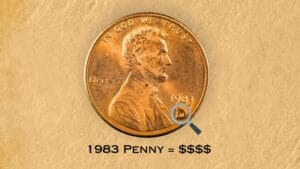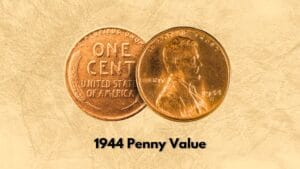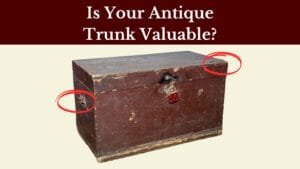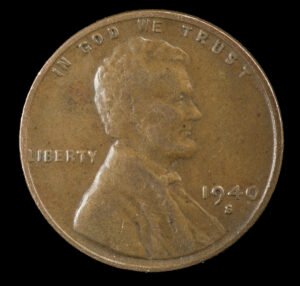Although a modern coin, the 1983 Lincoln Memorial Cent is one of the highly sought-after pennies among coin collectors, thanks to its range of values and unique attributes. However, due to their huge mintage, not all 1983 zinc pennies hit the price record, like the one that sold for $23,500 in an auction!
So, how do you know if your old cent from 1983 is worth a fortune?
From valuable coin grades and rare mint errors to coveted proof strikes, this guide offers an in-depth understanding of all the vital factors that help you identify and assess the worth of an old 1983 Lincoln Cent. You will also learn how to spot a fake or forged 1983 penny!
A Brief History of the 1983 Lincoln Memorial Cent
The 1983 Lincoln penny holds a unique place in numismatic history due to a significant change in its composition. Until 1982, Lincoln cents were made primarily of copper (95% copper, 5% zinc). However, starting in 1982, the United States Mint changed the composition to a cheaper zinc-based alloy (97.5% zinc, 2.5% copper) amid rising copper prices.
Congress minted the 1983 Lincoln Memorial pennies at Philadelphia (no-mint) and Denver (d-mint). San Francisco minted only a 3-million+ proof coins. This Lincoln design continued until 2009, when the reverse design was changed to feature four designs depicting Lincoln’s life, marking the bicentennial of his birth.
| 1983 Lincoln Penny | Key Features & Facts |
| Material Composition | Copper-plated Zinc (97.5% Zinc & 2.5% Copper) |
| Minting Location | Philadelphia, Denver, San Francisco |
| Minting Year | 1983 |
| Face Value | 1-cent ($0.01) |
| Weight | 3.11 grams (Copper) or 2.5 grams (Zinc) |
| Diameter | 19 mm |
| Thickness | 1.55mm |
| Designer | Victor D. Brenner (Obverse), Frank Gasparro (Reverse) |
| Mint Marks | ‘D,’ ‘S’ and No mint mark |
| Total Mintage | 14,219,554,428 |
How to Identify a 1983 Memorial Cent (Design & Composition)
Like its preceding coin, the 1983 Lincoln Memorial cent was designed by two sculptors, Victor D. Brenner, who designed the obverse, and Frank Gasparro, who designed the reverse.
1983 Lincoln Penny Obverse (Heads):
- A portrait of Abraham Lincoln, the 16th President of the States
- The minting year ‘1983’ on the lower right side
- The phrase ‘IN GOD WE TRUST’ on the top along the edge
- The word ‘LIBERTY’ on the left side, in compact kerning
- The mint mark “D” or “S” (if present) below the mint date
1983 Lincoln Penny Reverse (Tails):
- The nation’s name ‘UNITED STATES OF AMERICA’ on the top along the edge
- The image of the Lincoln Memorial (Washington, DC) with 12 columns, steps, and plinth
- The national US motto, ‘E PLURIBUS UNUM,’ above the hall
- The face value, ‘ONE CENT,’ written along the bottom rim in bold font
Coin Composition & Dimensions:
The 1983 Lincoln cent is composed of 97.5% zinc and 2.5% copper. The deviation from the previous copper and zinc composition to zinc also altered the coin’s weight, reducing it from 3.11 grams to 2.5 grams.
The 1983 Lincoln Memorial Cent measures 19.05 millimeters (0.75 inches) in diameter and has a thickness of 1.52 millimeters (0.06 inches) with a plain edge. These dimensions have been standardized for one-cent coins throughout much of American history.
5 Factors That Impact the Value of 1983 Lincoln Cents
An old 1983 Lincoln penny is generally worth $5 to $20 in good condition, but some other factors can also greatly impact its final value. Let’s understand these factors below:

1. Mintage & Mint Marks
The mint mark on the 1983 Lincoln Memorial cent can significantly impact its coin value due to differences in mintage numbers and rarity. The total number of Lincoln cents produced in 1983 is around 14,219,554,428, reflecting the coin’s high popularity in that year.
However, due to this high mintage, these pennies are easily available for collectors and, hence, are not generally that valuable unless featuring some special features.
- 1983 Lincoln Cent No Mint Mark: The Philadelphia Mint produced about 7,752,355,000 no mint mark pennies in 1983. With such a huge mintage, Philadelphia cents are generally the most common and have the lowest value. Even in high mint grades, like MS68, 1983-P Lincoln Cents are worth around $200 to $600.
- 1983-D Lincoln Cent: The Denver Mint produced 6,467,199,000 pennies with the “D” mint mark on the obverse in 1983. While slightly less common than Philadelphia coins, these are still very abundant. The value of 1983-D pennies ranges around $100 – $500 in high mint state grades and $0.30-$5 in uncirculated grades.
| 1983 Lincoln Memorial Mint Marks | Total Mintage |
| 1983-P Lincoln Penny (no mint mark) | 7,752,355,000 |
| 1983-D Lincoln Penny | 6,467,199,428 |
| 1983-S Lincoln Penny (Proof) | 3,279,126 |
2. 1983-S Lincoln Memorial Cent Proof
The San Francisco Mint produced 3,279,126 proof coins in 1983, which were not intended for circulation. These coins are generally more valuable due to their superior strike and finish, fetching up to $400 to $1,500+ in the highest PR70 grade and $10 to $100 in lower grades.
You can spot these coins by verifying the following features:
- An “S” mint mark on the obverse
- Highly polished and shiny, mirror-like fields (flat areas)
- Frosted raised design elements (Lincoln’s portrait, lettering, etc.) creating a cameo contrast with the mirrored fields
- Exceptionally sharp details due to being struck in a special die
2. Coin Grade & Condition
After mintage and rarity, a 1983 Lincoln Cent’s condition is crucial in assessing its worth. Generally, coin collectors consider cents graded by professional coin grading services, such as PCGS (Professional Coin Grading Service) and NGC (Numismatic Guaranty Corporation), as more valuable.
Based on coin grading, the 1983 Lincoln Pennies with the highest mint grades (MS) are worth the most, while Poor to Extremely Fine (XF) grade coins are worth the least.
You can refer to this 1983 Lincoln Penny value chart to find the average value of your coin based on condition.
| Coin Grades | 1983-P Lincoln Cent | 1983-D Lincoln Cent |
| Poor (0) to Extremely Fine (XF45) | Only a few cents | Only a few cents |
| Almost Uncirculated (AU50) to Mint State (MS60) | Below $5 | Below $5 |
| Mint State (MS60 – MS66+) | $5 – $15 | $5 – $15 |
| Mint State (MS67 onwards) | $10 – $350 | $15 – $400+ |
3. Rare Mint Errors & Anomalies in 1983 Memorial Cent
A 1983 Lincoln Memorial Cent with minting errors is worth more than a regular 1983 penny. So, look for the following errors and anomalies on your old coin.
Struck On a Copper Planchet (Transitional Error)
Despite the Mint’s official shift to zinc-based coins, a small number of 1983 zinc pennies were mistakenly struck on leftover copper planchets from the previous year. Due to their rarity, the “1983 copper penny” are highly sought after by collectors.
This rare planchet error can multiply the value of a 1983 penny up to thousands of dollars. For example, an MS-62 (Mint State 62) Red Brown-graded example of the rare 1983 copper cent was sold at Heritage Auctions for over $23,500. Generally, common 1983 MS62 penny specimens are worth only $10 to $20.
Struck On a Bronze Planchet (Transitional Error)
This error coin resulted from some 1983 coins being struck on the leftover bronze planchets from earlier errors instead of the new copper-plated zinc planchets. You can identify these with their 95% copper and 5% zinc composition and a weight of 3.11 grams.
Being a highly rare and valuable variety, this error coin can sell for up to $3,000 to $4,000 in low-mint grades. I found one of these rare 1983 transitional error pennies, graded MS-62, that sold for $3,120 on Heritage Auctions.
1983 Doubled Die Obverse (DDO)
This error coin features the doubling of letters in “IN GOD WE TRUST” and “LIBERTY,” numbers in “1983,” or Abraham Lincoln’s silhouette on the obverse. This happens when the coin blank is struck twice in the die during the minting process. Depending on the coin’s grade, the value of the 1983 1C DDO penny can potentially range from $100 to $2,000.
1983 Doubled Die Reverse (DDR)
This error also happens due to double striking, resulting in a distinct doubling of the design elements on the reverse. You can spot this doubling on the letters in “ONE CENT,” “UNITED STATES OF AMERICA,” and sometimes on the Lincoln Memorial building itself.

Struck On an Unplated Planchet
As per the new composition for 1983 pennies, the zinc planchets are supposed to be plated with a thin layer of copper before being struck. However, some planchets may sometimes skip the copper plating step and are struck with the 1983 Lincoln cent design.
This rare coin can easily be spotted with its silvery-gray tone instead of the coppery-red tone. Its value can range from $100 to $300 in commonly found mint grades, with higher-grade specimens fetching higher prices.
Off-center Strike
An off-center strike error happens when a 1983-cent coin is struck by the dies not in its intended position on the planchet, resulting in the design being partially off-center relative to the coin’s edge. These 1983 error coins are rare and can be worth up to $20 to $200, depending on condition and color grades.
4. Coin Colors & Toning
The value of a 1983 Lincoln Memorial Cent also largely depends on the coin colors. Based on the toning and discoloration over time, the Lincoln cents are generally graded as Red (RD), Red and Brown (RB), and Brown (BN).
- RD (Red): RD stands for “Red,” and it describes 1983 Lincoln cents that exhibit a bright, coppery-red color typical of uncirculated or minimally circulated coins without much toning. The RD 1983 zinc pennies are the most valuable ones.
- RB (Red and Brown): RB stands for “Red-Brown,” which denotes 1983 Lincoln cents that display a mix of red and brown colors due to partial discoloration in some areas. These are considered less common and valuable than fully red coins.
- BN (Brown): BN stands for “Brown,” referring to 1983 Lincoln cents that have fully developed a brown or dark color due to oxidation or toning. BN coins are typically the most common and the least valued among collectors.
Expert Tips to Spot a Fake 1983 Lincoln Penny
While you can easily assess the worth of an old 1983 Lincoln Memorial cent using the features listed above, there is a chance that you can trade a fake 1983 penny for big bucks. To avoid this, follow these expert tips to identify a 1983 Lincoln Penny counterfeit.
- Check the Weight: Use a precise digital scale to measure the coin’s weight. A genuine 1983 cent, composed of copper-plated zinc, weighs around 2.5 grams.
- Verify the Size: The cent’s diameter should be around 19.05 mm. Any significant deviation from this diameter could indicate a counterfeit.
- Check the Design Details: Check the placement of mint marks (if present), the font of letters on the obverse and reverse, and the numbers in the mint date. Compare these details with authentic 1983 cents.
- Observe the Edge: Inspect the penny’s edge closely for any signs of reed marks. Real 1983 Memorial Cents have a smooth edge due to their copper plating over a zinc core.
- Do a Magnet Test: Real 1983 pennies, made of copper-plated zinc, aren’t magnetic. Use a magnet to test your coin’s material. If it reacts, it is fake.
In conclusion, a regular 1983 Lincoln Memorial Cent may be common, but with rare mint marks, errors, and original color, it can stand out among other cents of this era and fetch surprisingly huge returns! If you are interested in exploring more valuable pennies, I have shared detailed guides on rare coins, like the 1982 penny, 1909 VDB penny, 1941 penny, and 1959 penny.
Note: This article is intended for informational, educational, and entertainment purposes only. Some images are illustrative and may not represent actual brands, products, or related entities. All trademarks, product names, brand logos, packaging, and other intellectual property referenced remain the exclusive property of their respective owners. Any brand mentions or references are provided solely for descriptive and educational context and do not imply any formal or commercial association.










